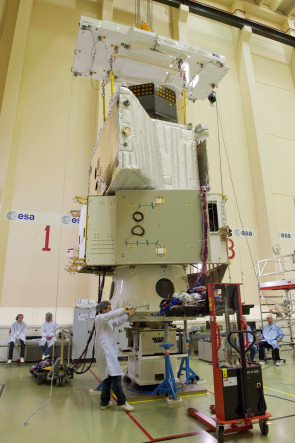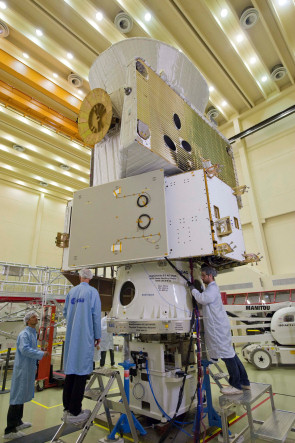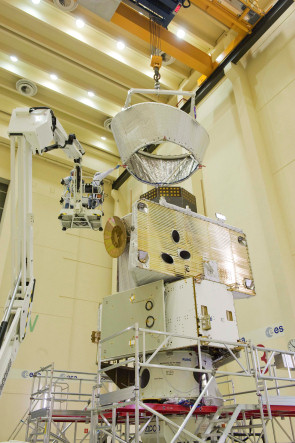#07: BepiColombo Composite Spacecraft Mass Properties Measurements
10 July 2012
The mass properties of the BepiColombo Mercury Composite Spacecraft have been measured. This is the first time that the spacecraft structural and thermal model has been fully integrated, producing the configuration in which it will be launched and effect the transfer to Mercury.The mass properties (total mass, centre of gravity [CoG] and moment of inertia [MoI] about all three axes) of the complete BepiColombo Mercury Composite Spacecraft (MCS), the configuration in which the spacecraft will launch and travel to Mercury, have been measured at ESA's European Space Research and Technology Centre (ESTEC) in Noordwijk, the Netherlands.
The mass properties of the MCS were measured using similar techniques to those that were employed for the Mercury Planetary Orbiter (MPO), the second of the mission components to have its mass properties measured at ESTEC. (See journal entry #06 for further details.) The Magnetospheric Orbiter Sunshield and Interface Structure (MOSIF) mass properties measurements were performed in November 2011. The mechanical properties of the Mercury Magnetospheric Orbiter (MMO) have been measured and analysed by the Japan Aerospace Exploration Agency (JAXA), which is responsible for this component of the mission. The MCS is made up of the MPO, the MMO, the Magnetospheric Orbiter Sunshield and Interface Structure (MOSIF), which provides the interface between the MMO and the MPO and shields the MMO from the Sun during the interplanetary journey, and the Mercury Transfer Module (MTM), whose primary task is to provide propulsion and attitude control for the journey to Mercury. The mass properties of the MTM will be measured later, after other mechanical testing and separation tests have been completed.
MCS testing
The tests were performed in the 'Hydra' cleanroom at the ESTEC Test Centre; the MCS assembly was installed on the WM50/6 test system for lateral CoG measurements, and on the M80/MPMA test system for longitudinal CoG and MoIs determination. The MCS had to be craned into position each time without the sunshield attached, to allow access to the lifting points on the MPO; the MMO is designed to be lifted alone, not as a structural element of the MCS stack.
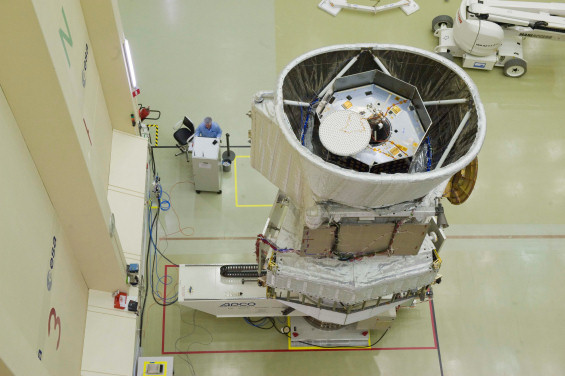 |
|
BepiColombo Mercury Composite Spacecraft on the M80/MPMA test system. Credit: ESA/Anneke Le Floc'h |
The WM50/6 was used to measure the position of the spacecraft CoG along the lateral (horizontal, in this configuration) axes. The M80/MPMA was used to determine the position of the spacecraft CoG along its longitudinal axis and the Products of Inertia (PoI) about all axes.
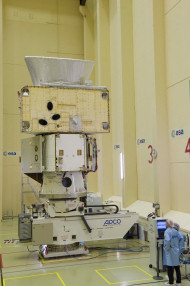 |
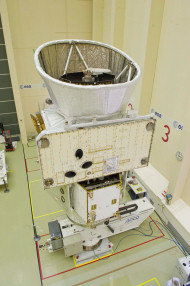 |
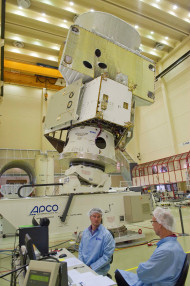 |
|
BepiColombo Mercury Composite Spacecraft on the M80/MPMA test system. Credit: ESA/Anneke Le Floc'h |
||
Over the next few weeks, the MCS Structural and Thermal Model will undergo vibration testing on the Quad Shaker and Multishaker in the ESTEC Test Centre. These tests will determine the structural resonances of the spacecraft and ensure that it meets the specifications for the mechanical environment during launch.
About BepiColombo
BepiColombo is Europe's first mission to Mercury. It is scheduled to launch in August 2015 and arrive at Mercury in January 2022. It will endure temperatures in excess of 350 °C and gather data during a one-year nominal mission, with a possible one-year extension. The mission comprises two spacecraft: the Mercury Planetary Orbiter (MPO) and the Mercury Magnetospheric Orbiter (MMO). During the journey to Mercury, the MMO will be shielded from the Sun by the Magnetospheric Orbiter Sunshield and Interface Structure (MOSIF), which also provides the interface between the MMO and the MPO. The fourth component of the composite spacecraft stack is the Mercury Transfer Module (MTM), whose primary task is to provide solar-electric propulsion for the journey to Mercury.
BepiColombo is a joint mission by ESA and the Japan Aerospace Exploration Agency (JAXA), executed under ESA leadership. The Prime Contractor for BepiColombo is Astrium GmbH.

